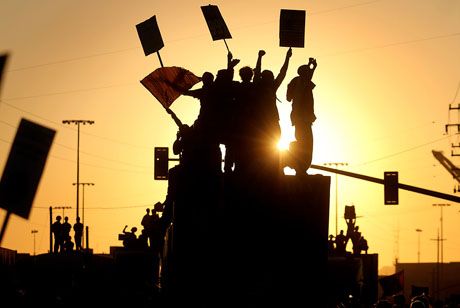Features
You are here
Arab Spring, the revolutions continue

January 3, 2012
The Arab Spring enters its second year continuing its twin demands of political freedom and economic justice. Amidst deepening economic crisis and ongoing Western intervention, with international and local forces attempting to contain the revolutions, workers have the power to spread them.
The Arab Spring that inspired the world began on December 17, 2010 when a desperate young Tunisian fruit seller, Mohamed Bouazizi, set himself on fire in front of the Sidi Bouzid regional council in central Tunisia.
He sparked an uprising in Tunisia against political repression and economic austerity, and four weeks later, the repressive government that ruled for 23 years came to an end after a general strike.
Tunisians participated in elections, and a new freely-elected government led by the moderate Islamic party Ennahda received a vote of confidence in parliament, and was sworn in December 24. While President Marzouki has called for an end to strikes and sit-ins, driving a wedge between the political and economic aspirations of the Tunisian Revolution, Tunisian workers can push the revolution forward.
Egyptian Revolution
Inspired by Tunisia, on January 25, a mass protest sparked a movement against Mubarak’s regime. More than 600 protestors were killed. On February 9 mass strikes erupted, and on February 11 Mubarak stepped down and a military council was formed to run the country’s affairs.
But the brutality against peaceful protestors in Tahrir Square continued even after the fall of Mubarak. On October 9 Coptic Christians showed their anger and disappointment against the army after at least 25 Christians were killed as troops brutally attacked their protest. Tens of thousands of Egyptians joined protests on November 25, demanding an end to military rule, and about 42 protestors were killed in one week. Then battles between protestors and the military left at least 17 dead in December. The videos showing the Egyptian Army attacking and arresting peaceful activists, and stripping and beating women, shocked people around the world. But this was followed by a 10,000-strong march of women, showing the determination of the Egyptian Revolution.
Amidst the brutality the Egyptian regime held elections starting November 28, during which the Muslim Brotherhood received about 40 per cent of votes cast for party lists in the second round. They were the largest opposition force to Mubarak but have since supported the military regime and called off strikes and demonstrations.
But Egyptian workers are continuing to organize independent trade unions and strike for economic and political demands. Mass strikes toppled the dictator, and have the power to topple the dictatorship.
The slogan “People demand the fall of the regime” has united Arabs in Tunisia, Egypt, Libya, Yemen, Bahrain, Syria, and Saudi Arabia in 2011—producing a major challenge to Western imperialism. NATO used the pretext of bloodshed to launch a war in Libya, reducing the revolution to minor changes, and threatens to derail the revolt in Syria as well.
Hands off the Arab Spring
On the other hand, the same Western powers are silent towards Yemen, Bahrain and Saudi Arabia. The Yemeni President Ali Abdullah Saleh resigned, but the system remained the same. The Saudi and the Bahraini governments continue repressing pro-democracy protestors and activists—killing, injuring and arbitrarily arresting thousands.
The hope for a continued Arab spring in 2012 lies with the people of the region themselves—especially workers organizing unions and mass strikes—and a halt to Western military intervention.
Section:
- Log in to post comments










